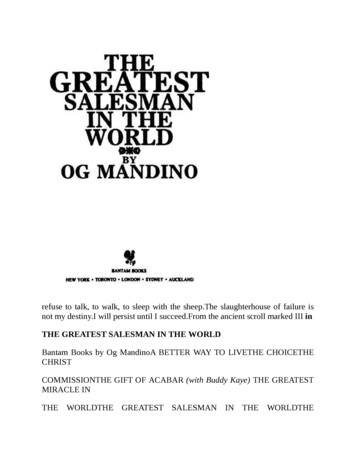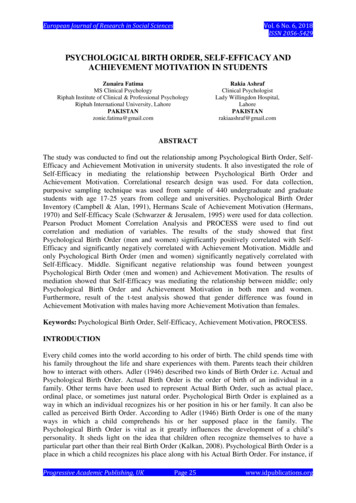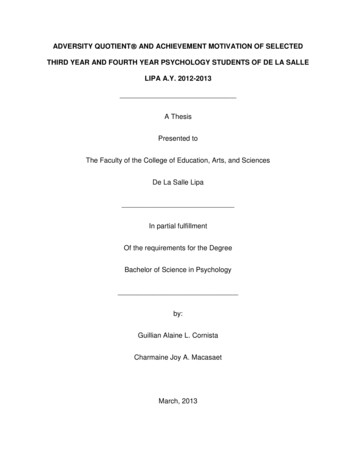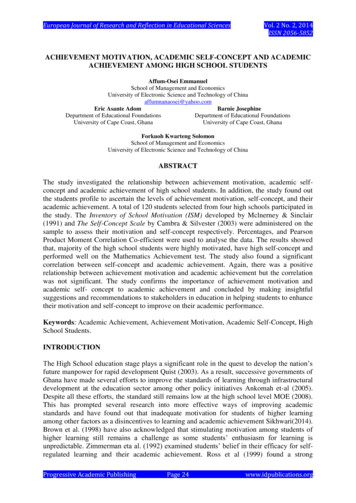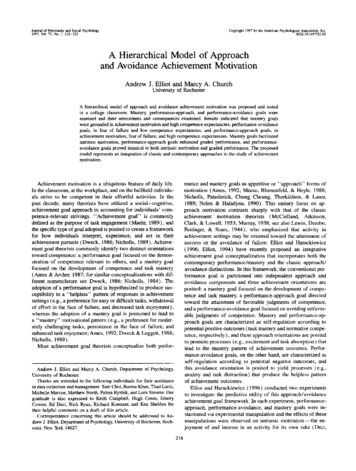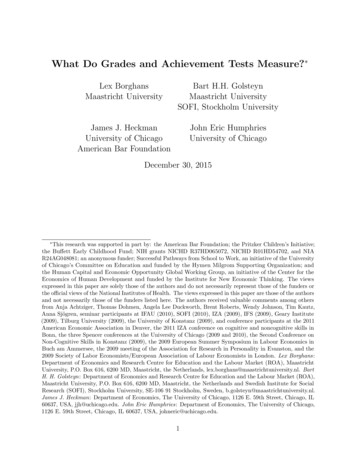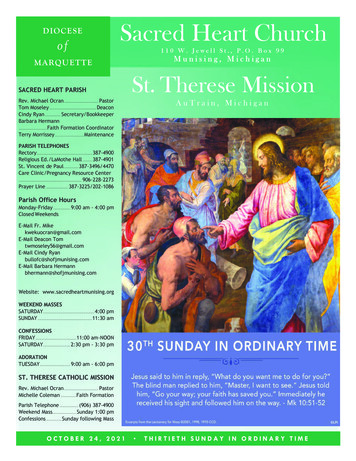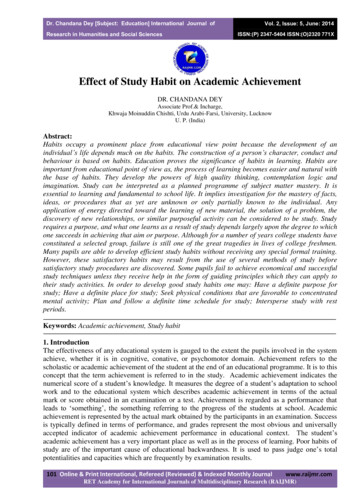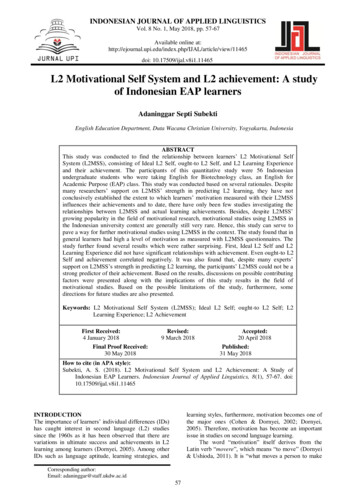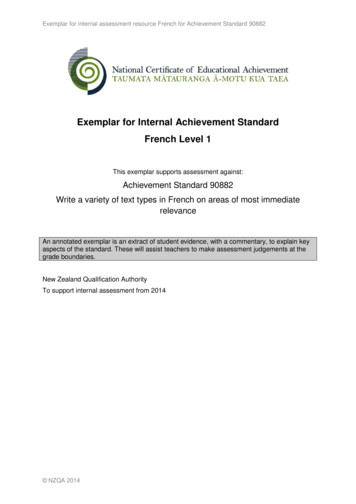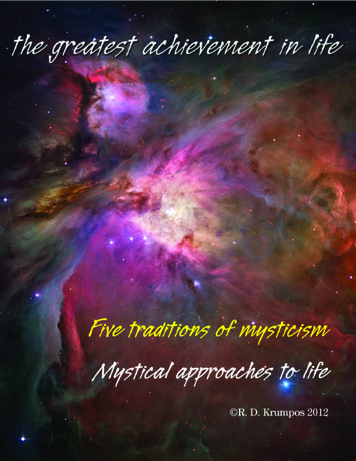
Transcription
The Greatest Achievement in Life1 R. D. Krumpos 2012
the greatest achievement in lifeFive traditions of mysticismMystical approaches to life R.D. Krumpos 2012Proofread by Dr. Paul Martin at The University of Adelaide.eBook Design by Solarity Design www.solaritydesign.comCover Image: Orion Nebula, birthplace of the stars in our Galaxy.Courtesy of NASA, ESA, M. Robberto (Space Telescope Science Institute/ESA)and the Hubble Space Telescope Orion Treasury Project Teamwww.suprarational.orgThis ebook is a printable pdf.To enlarge the typeface, click on the box for Sidebar or the sign at the top of the screen.The Greatest Achievement in Life2 R. D. Krumpos 2012
ContentsFive traditions of mysticismMystical approaches to lifeIntroduction 4The big picture 56What’s in a Word? 6The divine is not. 58Mysticism defined 8A divine formula? 60What is Reality? 10Upside down 62Prominent mystics: J/C/I 12Love, knowledge and. 64Prominent mystics: H/B 14Feel good - do good 66Mystic viewpoints 17Discard, abandon & realize 68Quotations of mystics 19Beyond words 70Our different worlds 21Oneness in separateness 72Quotations of mystics 23Finding the soul 74Mysticism is not. 25A little of this, a little of that 76Quotations of mystics 27Heads up! 78To the non-religious 29The grand excuse 80Quotations of mystics 31Contemporary views 82Warnings! 33Beyond me 84Quotations of mystics 35Beyond other 86Reality is One 37Wake up! 88Quotations of mystics 39Outside the box 90Preconditions to learning 41Other considerationsQuotations of mystics 43Divine laity 92Looking beyond 45Duel of the dual 94Quotations of mystics 47Asleep 96Some differences 49Be realistic 98Primary Bibliography 51Specialized Bibliography 100The Greatest Achievement in Life3 R. D. Krumpos 2012
IntroductionThe first essay, What’s in a Word?, briefly outlines some of the fundamentaldifferences between five of the largest religions and among the principaldivisions in each faith. The following essays attempt to summarize manysimilarities among the mystical traditions in those religions. The 120quotations of mystics highlight common views.Essays are based on talking with mystics in 12 countries and 180 books.100in the primary bibliography. Many people were consulted, including thedirectors of a Buddhist Center and of the Eastern Orthodox theologicalinstitute at two major universities, a Vedanta Society swami, the director ofan Islamic Center, the director of a Reform theological college, the abbot ofa Theravada temple, a Cistercian monk, a Hindu abbess, a Sufi shaykha, anda professor at a university for Judaism, plus 10 professors who each teachcourses on comparative mysticism. Their suggestions led to many revisions.The practices and/or systems of these five traditions of mysticism do varywidely, employing dissimilar terminology and concepts. These essays usegenerally acceptable terms and note alternate words and definitions whenappropriate. Some of the quotations from mystics:“One Nature, perfect and pervading, circulates in all natures. One Reality, allcomprehensive, contains within itself all realities.” Yung-chia Ta-shih BNote: (685–713) Disciple of Hui-neng“To gauge the soul we must gauge it with God, for the Ground of God and theGround of the soul are one and the same.” Meister Eckhart C“Wherever you look.see that one unique Presence, indivisible and eternal, ismanifested in all the universe. That is because God impregnates all things.”Anandamayi Ma H“Behold the One in all things; it is the second that leads you astray.” Kabir I/H“There exists nothing which is not united to Him and which He does not find inHis own essence.” Moses Cordovero J“One in all, all in One. If only this is realized, there is no worry about not beingperfect.” The Third Patriarch of Zen [Seng ts’an] BThe Greatest Achievement in Life4 R. D. Krumpos 2012
“Eternally, all creatures are God in God. So far as they are in God, they are the same life,same essence, same power, same One, and nothing less.” Henry Suso C“For the Self [soul] is not the ego; it is one with the All and the One and in findingit it is the All and the One that we discover in our Self.” Sri Aurobindo H“I went from God to God, until they cried from me, ‘O thou I.” Bayazid of Bistun“They are then actually united with the Divine Essence and, in all aspects, yoursoul is included with them.” Israel ben Eliezer [Ba’al Shem Tov] J“The great path has no gates, thousands of roads enter it. When one passes through thisgateless gate he walks freely between heaven and earth.” Zen poem B“The soul lives by that which it loves rather than in the body which it animates.For it has not its life in the body, but rather gives it to the body and lives in thatwhich it loves.” St. John of the Cross C“Liberation cannot be achieved except by the perception of the identity of theindividual spirit with the universal Spirit.” Shankara [Sankara] H“I am He whom I love, and He whom I love is I. We are two spirits in one body. Ifthou seest me, thou seest Him. And if thou seest Him, thou seest us both.”Hallaj I“A man should actually detach his ego from his body until he has passed throughall the worlds and become one with God.” Maggid of Mezerich [Dov Baer ofMezerich] JTrue mystics had direct experience in divine union. Within these essays, oneness,union and unity all mean to be consciously in the unifying divine essence. Theseare some terms which are used in mysticism most often, but they are simply words.What is is not changed by what it is called. People’s opinions too often distort it.Note: Comparative religions use BCE or CE, Common Era, for the Christian BC or AD; ca. isapproximate. The religious calendar varies among each of the five faiths.The Greatest Achievement in Life5 R. D. Krumpos 2012
What’s in a Word?The word God, as used in English, is Allah in Arabic, Brahman in Sanskrit andha-Shem (the Name) in Hebrew. God is Theos in Greek, the first written languageof the New Testament. Nirvana in Buddhist Sanskrit can also mean absolute Truth:ultimate Reality.Hinduism had no one founder; the Vedas advanced orally about 200 years beforebeing recorded in Sanskrit from ca. 1300–600 BCE. The Hebrew Bible developed atleast 300 years after Moses, ca. 1000–400 BCE. Gautama had been born a Hindu andtaught in Prakrit; Buddhism’s first written canon was in Pali nearly 400 years later,ca. 17 BCE. Jesus was born a Jew and preached in Aramaic; the New Testamenthad evolved from ca. 100–367 CE. Muhammad spoke Arabic; the written Qur’an wasformed within 30 years of his death in 632 CE. Scholars do not agree on those dates.*Hindu scriptures also refer to Ishvara, amore personal aspect of Brahman, and oftenMany other religions have differentto Vishnu and Shiva, two of Brahman’strinity, plus incarnations in Krishna andwords for God and a few, as inRama. The Hebrew Bible uses the sacred,Buddhism, do not include a Supremeunspoken, YHVH (YHWH) for God; Adonaireplaces it when reading Jewish scriptures.Being or Creator. Some give GodHa-Shem is used in conversation. Mahayanapersonal qualities, while most speak ofand Vajrayana vehicles may consider theDharmakaya (“dharma-body” or BuddhaGod as a spiritual omnipresence ornature) more correct than Nirvana, finalan all-pervading force.realization of the Theravada. In the firstwritten New Testament, Jesus referred toGod as Abba (Father) and Lord applied to both the persons of the Father and theSon in the Trinity. In the Qur’an, al-Haqq (the Truth, the Reality) is supremely thetitle of Allah. Islam has “99 Beautiful Names” for Allah’s perfection; other faithscredit many attributes to God. In English, Absolute, Almighty, Deity, Supreme andother words are used to refer to God; divine, holy, omnipotent, omniscient, andother adjectives usually apply only to God.Many other religions have different words for God and a few, as in Buddhism, donot include a Supreme Being or Creator. Some give God personal qualities, whilemost speak of God as a spiritual omnipresence or an all-pervading force. Among theother religions which are still practiced today: Aboriginal traditions, African tribalbeliefs, Baha’i, Druze, Jainism, Native American faiths, Polynesian spirit worship,Shinto, Sikhism, Taoism, Tenrikyo, Yoruba, and Zoroastrianism. Later prophets haddeveloped new traditions, like Jewish Kabbalah, had gained new revelations, as inThe Greatest Achievement in Life6 R. D. Krumpos 2012
The Church of Jesus Christ of Latter-day Saints (Mormons), or had founded newreligions, such as Baha’i. There are hundreds of religions and faiths.The Vedas, most sacred to Hindus, were rejected by Buddhists who also defined manySanskrit words differently, e.g. nirvana. The first five books of the Hebrew Bible,the Torah, are most revered by Jews and are studied by most Christians. Practicesand customs may vary between countries, as apparent among the predominatelyMuslim states, or blend in local mythology, such as in Hinduism on Bali. Doctrinefor any one religion may differ between its divisions or their branches, like withinthe many Protestant denominations.In Vedanta, Brahman is considered as the One God; Hindus of Shaivism, Shaktismand Vaishnavism may worship a chosen god, goddess or incarnation who emanatesfrom Brahman. In Judaism, behavior and worship may vary among movements:Conservative, Hasidism, Orthodox, and Reform. Mahayana Buddhists rely onguidance of others and prayer; Theravada stresses self-reliance and good works;Vajrayana has secret rituals and metaphysics. Eastern Orthodox, Protestant, RomanCatholic, and other Christians differ often on grace, the Trinity and sources ofdoctrine. Ibadi, Shi’a and Sunni Islamic sects disagree on Muhammad’s successorsand on the status of imams; Sufi orders among them may worship differently.Hindu texts written in classical Sanskrit sometimes changed when translated intoIndia’s 22 modern languages or into English. The Hebrew Bible varied in Greek andLatin; except for Protestants, the canon of Christianity’s Old Testament includedmany books not in Judaism’s canon. Buddhist texts in Pali and Sanskrit were ofteninterpreted differently in other Asian languages and Ch’an/Zen downplays the useof scriptures. The New Testament has had many changes during translations, literaland idiomatic. The Qur’an was written only in Arabic for more than 1,200 years; firsttranslations were in the early 1900’s, but are not considered true Qur’an.Reading the mystics of all religions can help to overcome these many apparentdifferences. Mysticism’s message seems to be a consensus: The essence of the Oneis the essence of All. Although the ultimate Reality is the same, each experience ofit can vary. That applies to each mystic as well as between mystics.* Some scholars say that the oral traditions of Hindu and Jewish texts were first written in the 3rdCentury BCE and the New Testament in the 1st Century CE (AD).Note: Five of the largest religions are mentioned in order of their usual historical origins. All hadoriginated in Asia (India and the Near East), but Judaism, Christianity and Islam are herein referredto as “Western” (yet the biggest Muslim populations are in Indonesia, Pakistan, Bangladesh, andIndia). Mysticism is a tradition in some other faiths, too. Shinto of Japan - larger than Judaism worships “kami,” heavenly and earthly divine powers shared by some humans.not as mystics.The Greatest Achievement in Life7 R. D. Krumpos 2012
Mysticism definedOxford Dictionary of World Religions, by John BowkerPublished by Oxford University Press 1997, 2005:Mysticism. “The practices and often systems of thought which arise from andconduce toward mystical experience. Mystical systems are distinguishedfrom other metaphysical systems by their intimate connection to a quest forsalvation, union and/or liberation realized through forms of mental, physical andspiritual exercise in a classic definition. Mysticism, according to its historical andpsychological definitions, is the direct intuition or experience of God; a mystic is aperson who has, to a greater or lesser degree, such a direct experience; one whosereligion and life are central not merely on an accepted belief or practice, but onthat which he regards as first-hand personal knowledge.”Note: Non-theistic religions, such as Buddhism, seek the same ultimate Reality, but it is notconceived as God.Judaism. “Kabbalah is teachings of the Jewish mystics. The term encompassesall the esoteric teachings of Judaism which evolved from the time of the secondTemple. More particularly, it refers to those forms which evolved in the MiddleAges. Kabbalah draws on the awareness of the transcendence of God, and yet ofhis immanence. God can most closely be perceived through contemplation andillumination. God both conceals and reveals himself. Through speculation andrevelation, the hidden life of God and his relationship with his creation can be moreeasily understood. Since mystical knowledge can so easily be misinterpreted itsspread should be limited to those of a certain age and level of learning.”Note: The Zohar emphasized contemplation; Kabbalah of Hasidism added enthusiasm.Concise Guide to World Religions, by Eliade and CoulianoPublished by HarperCollins San Francisco 1991, 2000:Christianity. “.a brief survey of the rich mystical tradition of Christianity, whichcan be envisaged as a form of Platonic contemplative asceticism integrated withdevotional and often liturgical activities. In its multifarious historical occurrences,Christian mysticism embraces almost all available mystical phenomenology,emphasizing to almost the same extent both ecstasy and introspection. The mysticalexperience tends toward the union with God in the complete surrender of the bodyand the world.”Note: Eastern Orthodox mysticism seeks union with the Godhead through the three persons,followed by a “deified” participation in life. All Friends (Quakers) should seek the Inner Light, followdivine leadings and regard all of life as sacramental.The Greatest Achievement in Life8 R. D. Krumpos 2012
World Religions-Ancient History to Present, by Geoffrey ParrinderPublished by Facts on File 1971, 1985:Islam. “The objective of Sufism, as all mysticism, is to attain union with God.Mysticism seeks for an immediate experience of the divine reality through thesuppression of the ego. The method of attaining this most coveted experience,however, demands insight into a special and hidden brand of knowledge. Sufidoctrine teaches that, beside the usual rules for religious life, set out in therevelation and the prophetic sunnah, there is another and deeper level of spiritualmeaning, which the prophet shared with only a few of his chosen companions. Therevelation, thus, wears two faces, one open and obvious, and the other only to beseen by those who have been instructed in its secrets.”New Penguin Handbook of Living Religions, by John R. HinnellsPublished by Penguin 1997, 2003:Hinduism. “Another concept, central and essential to Hinduism, is moksha(liberation), which is also one of the four Hindu aims of life. That from whichliberation is sought is samsara, the cycle of birth and rebirth. The part of the humanindividual which is immortal.passes at death to diverse heavens and hells where itworks out its karmic debt and is then reborn in the form it has deserved. This cyclecontinues endlessly unless it merits, or is blessed with, a lifetime during which,through spiritual efforts, the intervention of a guru or the grace of God, moksha isattained, whereby it passes out of the cycle altogether.”Note: The notion of interim heavens and hells is not supported by all Hindu schools.Buddhism. “The main aim is to emphasize immediate accessibility of directrealization. Enlightenment is to be striven for and realized in this very life. Ch’an[Zen] teachers claimed a transmission outside doctrines - direct and wordlesscommunication between teacher and pupil. Later tradition lays great stress onthis transmission. Practical action was to be preferred to study. Ch’an [Zen] oftenstresses the suddenness of realization of enlightenment, but in fact different degreesof realization were usually recognized.”Note: All Buddhism seeks enlightenment; Ch’an/Zen and Tibetan Tantrism may be regarded asmore “mystical.” The term “mysticism” is seldom used by Buddhists.The Greatest Achievement in Life9 R. D. Krumpos 2012
What is Reality?Truth is One, although people call it by many names. The world’s religionshonor prophets, messengers and/or incarnations: Krishna, Moses, Buddha, Jesus,Muhammad, and others throughout the ages. They have all sought to bring peoplecloser to the divine. In the mystical tradition of religions, we can directly experiencethe divine in this life by giving up our ego and individuality to be in the soul, thenconsciously sharing in the unitive divine essence.Spiritual liberation is the final objective, yet itmust be sought in stages. Our attachment to ourouter self, and its interaction with the externalworld, blinds us to the serenity of experiencingour inner self flowing within the universal whole.Few people are aware that the divine essence isthe essence of All. That art Thou, the divine isin you, is a declaration of many scriptures; mostmystics believe that essence to be the ultimate,eternal Reality. It is here and now.How can we realize enlightenment,or complete intuitive insight into unitywith the divine, in one lifetime when themodern human race has notachieved perfection in 40,000 years(400,000 for homo sapiens)?Our inner self, or soul, is far more real than our ego self, which is cloaked in variousnames, shapes and circumstances. Someone’s full name, their outward descriptionand occupation tells very little about the true nature of the person. Also, manypeople often use external means to contemplate the divine: sacred scriptures,houses of worship, shrines, or sacred art forms. They can provide a light to guideus away from mundane concerns for survival, satisfaction and success, still noneof them can entirely convey the spiritual Reality of the divine. Physical and mentalappearances can be restricting.It is not easy to leave the countless attractions of the material world nor the myriadof thoughts in the mind. Most religions use chanting, singing, dancing, recitation,and/or prayer to help us put aside our worldly activities to temporarily focus onthe divine. Simple meditation can bring us centering inner peace. Our ego self thenreturns us to the limited realities perceived by our senses and minds to interactwith our physical and social environment.How can we realize enlightenment, or complete intuitive insight into unity with thedivine, in one lifetime when the modern human race has not achieved perfection in40,000 years (400,000 for homo sapiens)? Many people believe in only a single life,which might qualify us for an eternal afterlife. Others think we must live throughnumerous lives until we are in conscious oneness with the divine.The Greatest Achievement in Life10 R. D. Krumpos 2012
Why were we each born with our individual attributes, family and place? Those whobelieve in rebirth can easily understand that our circumstances at birth result fromour conduct in a past life. Many persons call seeming good fortune and bad luckdivine will. Others name it divine justice, the consequences or reactions causedby our own actions in this or previous lives. Some scientists say it is chance.Many mystics view this life as theater. Following divine law we must performaccording to our script, but only to please the divine, the producer and director, notfor the applause of the audience or the praise of fellow actors. People usually act toachieve personal benefits and believe their characters and the play are reality. Ourultimate goal is to be aware of universal Reality as the true stage of life, releasedfrom attachment to our fictitious human roles.Any religion in practice was affected by the circumstances of history and its rulesand rituals are an interpretation by its leaders of what its believers must do to followdivine teachings. What might seem necessary for today, or for one person, may notbe correct for tomorrow or for another person. We must seek our own liberationfrom mundane reality; for mystics this means to gain freedom from our limited selfto realize oneness with the limitless divine.Mysticism seeks to join, or unite, our inner self with the divine by spiritualdisciplines of devotion, knowledge, selfless service, and/or meditation. What youdo matters greatly to what you will become: that is divine justice. How you do it,through Islam, Christianity, Buddhism, Judaism, Hinduism, or outside these faithsis important when it is the right way for you: that is divine law. One is Truth: trueReality transcends the boundaries of our beliefs. Thou art That: you are in thedivine essence; you must be dedicated to fully realizing it.Our religion may be right for us, nevertheless that does not mean billions of othersare wrong. What of the 100 billion* people who lived outside of our faith since theorigin of our species? Religions differ in approach, beliefs and practices, althoughthe divine Reality they seek is the same. Their mystics used the words and conceptsunderstood by followers of their faith, but these are just alternate ways of trying toexpress the One underlying Truth.Divine union must be sought in this life, even for those believers in many lives. Wecannot simply wait for death to bring us to the divine; waiting may result in ourlosing everything which we seek.Note: In Hinduism, “jiva” is a soul identified with the ego self; “atman” is the true Self or soulidentified with Brahman. In some of the traditions of mysticism, a soul might have many aspects;in these essays, the word “soul” is only used in its divine aspect.*See Wikipedia on the Internet for surprising historical statistics on “World Population.”The Greatest Achievement in Life11 R. D. Krumpos 2012
Few mystics wrote books or had their teachings recorded by others; fewer yetwere published and are available today. There have been millions of mystics,but some are especially well known for their leadership, writings or teachings.Some prominent mystics of Judaism(add ca. 3761 years for the Jewish calendar) [23 quotes from 17 mystics]:* Abraham ben Samuel Abulafia (1240–ca. 1291):Spanish kabbalist. Wrote Light of Intellect and other essays.* Joseph ben Ephraim Caro (1488–1575):Rabbinic authority. Wrote Beit Yosef (House of Joseph), code of Jewish law.* Moses Cordovero (1532–70):Spanish kabbalist. Wrote Orchard of Pomegranates, Precious Light, etc.* Dov Baer of Lubavitch (1774–1827):Russian Hasidic kabbalist. Son of Shne’ur Zalman. Wrote Tract on Ecstasy.* Dov Baer of Mezhirech (d. 1772):Hasidic leader and kabbalist scholar. Teachings in Maggid Devarav le-Ya’aqov.* Eleazar ben Judah of Worms (ca. 1165–1230):German scholar. Wrote Roke’ah and The Secret of Secrets.Isaac the Blind (ca. 1160–1235):Described as ‘the father of the Kabbalah’; wrote commentary to Sefer Yezirah.* Israel ben Eliezer [Ba’al Shem Tov] (1700–60):Founder of East European Hasidism (criticized for “enthusiasm”).* Abraham Isaac Kook (1865–1935):From Latvia; Ashkenazi Chief Rabbi of Israel (wrote The Lights of Holiness).* Isaac ben Solomon Luria [the Ari] (1534–72):Egyptian kabbalist. Wrote commentary on The Book of Concealment.* Moses ben Shem Tov de Leon (ca. 1240–1305):Spanish kabbalist. Wrote Mystical Midrash, foundation for the Zohar.* Rebi Nahman of Bratslav (1772–1811):Controversial Ukrainian zaddick. Followers are called “the dead Hasidism.”* Philo (ca. 20–50 B.C.E.):Hellenistic Jewish philosopher (reconciled early Greek and Jewish teachings).* Shne’ur Zalman of Lyady (1745–1813):Founder of Habad Hasidism. Wrote Likkutet Amarim, its principle text.* Simeon Bar Yohai (2nd C.):Moses de Leon atributed the Zohar to him (central writings of the Kabbalah).Hayyim ben Joseph Vital (1542–1620):Syrian Jewish kabbalist. Wrote Tree of Life and The Book of Visions.* Quoted. Also quoted: Martin Buber, Shmelke of Nikolsburg, and Yehiel Mikhal of Zlotchov.Some prominent mystics of Christianity(BCE/CE, Common Era, are BC/AD) [23 quotes from 20 mystics]:* Saint Thomas Aquinas (ca. 1225–74):One of the greatest Catholic theologians (gained union very late in his life).* Saint Athanasius (ca. 296–373):Bishop of Alexandria; church father. Wrote On the Incarnation; Life of Antony.* Saint Augustine of Hipo (354–430):Convert from Neoplatonism (mystical insights and later doctrines conflicted).The Greatest Achievement in Life12 R. D. Krumpos 2012
* Augustine Baker (1575–1641):Influential Benedictine (English exile). Wrote Holy Wisdom (Sancta Sophia).* Saint Bernard of Clairvaux (1090–1153):Monastic reformer and mystical writer (Cistercian abbot and crusader).Jakob Boehme (1575–1624):German Lutheran writer. Claimed direct divine inspiration for Aurora.* Saint Catherine of Genoa (1447–1510):Worked in a hospital in Genoa. Wrote Dialogues on the Soul and the Body.* Dionysius [Pseudo-Dionysius](ca. 500):Converted by Paul [Syrian monk?] Wrote Mystical Theology among others.* Meister Johannes Eckhart (ca. 1260–1327):German theologian/preacher of Dominican Order. Extremely influential.* George Fox (1624–91):(English) founder of the Society of Friends (Quakers). Wrote his Journal.St. Gregory I ‘the Great’ (ca. 540–604):Elected Pope from 590. Wrote Pastoral Care, Commentary on Job and others.* Saint Gregory of Nazianzus (329–89):Cappadocian father. Wrote Theological Orations and Philocalia of Origen.* Saint Gregory of Nyssa (ca. 330–95):Cappadocian father. Wrote Catechetical Orations, Life of Moses and others.Saint Gregory Palamas (ca. 1296–1359):Greek Orthodox archbishop. Wrote Triads in Defence of the Holy Hesychasts.* Bede Griffiths (1907–93):Benedictine monk; prior of ashram in India. Wrote Marriage of East and West.* Saint John of the Cross (1542–91):Founder of the Discalced Carmelites. Wrote Dark Night of the Soul and others.* Nicholas of Cusa (ca. 1400–64):German Christian philosopher; made a cardinal. Wrote De Docta Ignorantia.* Saint Jan van Ruysbroek [Ruusbroec] (1293–1381):Flemish Christian mystic. Wrote The Spiritual Espousals.* Henry Suso (ca. 1295–1366):German Dominican monk. Wrote Little Books of Truth and Eternal Wisdom.* Saint Symeon the New Theologian (949–1022):Byzantine mystic; Abbot at St. Mamas in Constantinople (Istanbul).* Saint Teresa of Avila (1515–82):Spanish Carmelite abbess. Wrote the Interior Castle and her Autobiography.* Saint Tikhon of Zadonsk (1724–83):Russian Orthodox bishop and mystical writer (revered by Dostoevsky).* Quoted. Also quoted: Angela of Foligno, Maximus the Confessor and Simone Weil.Some prominent mystics of Islam(subtract ca. 622 years for the Islamic calendar) [23 quotes from 19 mystics]:Abd al–Karim al-Jili (ca. 1365–1412):Mystic (taught in Baghdad). Wrote The Perfect Man, referring to Muhammad.* Abu Yazid al–Bistami [Bayazid of Bistun] (d. 875):Persian ascetic (saint). Wrote nothing, but much quoted by Sufis.* Abu Hamid Muhammad al-Ghazali (1058–1111):Master of jurisprudence. Wrote Revival of the Religious Sciences.* Abu ‘l-Mughith al-Husain b. Mansur al-Hallaj (857–922):Controversial Iraqi Sufi (saint). Wrote Kitab al-Tawasin.The Greatest Achievement in Life13 R. D. Krumpos 2012
Abu ‘l-Qasim al-Junaid (d. 910):(Saint) Laid the foundations for much of the development of “sober Sufism.”Farid al-Din Attar (d. 1229):Persian mystical poet. Wrote Language of Birds, Divine Book and others.* Dhu’l-Nun al-Misri (d. 859):Egyptian spiritual head of Sufis of his time. Leading authority on ma’rifa.* Hajji Bektash Vali (12th C.):Founder of Turkish Derwish order, controversial Shi’ite sufi.Hasan al-Basri (632–728):One of the influential Sufis, regarded third master after Muhammad and ‘Ali.* Muhyi al-Din Ibn (al-)’Arabi (1165–1240):Great Sufi (saint). Wrote Meccan Revelations, Bezels of Wisdom, etc.Sir Muhammad Iqbal (1876–1938):Poet of Lahore (saint). Wrote Reconstruction of Religious Thought in Islam.* Jalal al–Din Rumi [Mawlana] (1207–73):Great mystic poet (saint). Wrote Poems of Shams-i-Tabriz and many others.* Mawlana Nur al-Din ‘Abd al-Rahman Jami (1414–92):Afghan Sufi poet. Wrote The Seven Thrones among many others.* Rabi’a al-Adawiyya (ca. 713–801):Outstanding female Sufi (saint) (important proponent of selfless love of God).* Quoted. Also quoted: Hazreti ‘Ali, Khwaja Mir Dard, Hazrat Inayat Khan, Pir Vilayat Inayat Khan,Nawab Jan-Fishan Khan, Abu-Sai’d Abi’l Khayr, Sharafuddin Maneri, Rauf Mazari, Pahlawan-i-aif, andMahmud Shabestari.Note: Listings were extracted from the Oxford Concise Dictionary of World Religions.All Hindus and Buddhists should follow the mystical quest and most believe indivine law, divine justice, rebirth, and eventual liberation, but their approachand doctrines are very different, with many variations among their schools.Some prominent mystics of Hinduism(this aeon, or yuga, began 3102 B.C.E.) [23 quotes from 12 mystics]:Abhinavagupta (960–1050):Theologian of Kashmir Shaivism. Wrote Light on Tantra and on aesthetics.* Anandamayi Ma [Nirmala Sundari Devi] (1896–1982):She attained union at age 18 without aid of scriptures or guru.* Sri Aurobindo [Aurobindo Ghose] (1872–1950):Founded ashram in Pondicherry. Wrote The Life Divine and others.* Badarayana (1st C. B.C.E./4th C. C.E.):First propounded the basic teaching of Vedanta in the Bhramasutra.* Basava [Basavanna] (ca. 1106–67):Founder of Lingayata, known as Virashaivism. The body is the true temple.* Sri Krishna C(h)aitanya (ca. 1485–1533):(Maratha Saint) Major influence on development of devotion to Krishna.* Jnanesvar [Jnanadeva] (1275–96):At age 15 wrote The Lamp of Plain Meaning, revered in Marathi literature.* Kanada [Kanabhuj] (ca. 2nd C. B.C.E.):Founded Vaisesika system. Developed atomic theory of nature.The Greatest Achievement in Life14 R. D. Krumpos 2012
* Lalla [Lal Ded] (14th C.):Shaivite poe
Five traditions of mysticism Mystical approaches to life R.D. Krumpos 2012 . Essays are based on talking with mystics in 12 countries and 180 books.100 in the primary bibliography. Many people were consulted, including the . for the Christian BC or AD; ca. is approximate. The religious calendar varies among each of the ive faiths. The .


